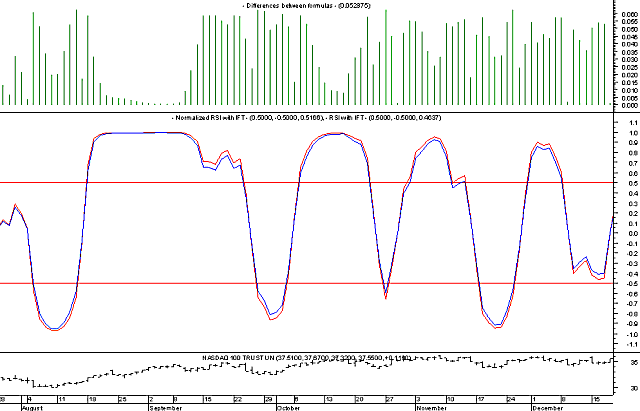Traders' Tips from TASC Magazine
The Inverse Fisher Transform
John Ehlers' article, "The Inverse Fisher Transform," includes the Trade Station code for two indicators. The MetaStock code for those Indicators is listed below.
To enter this indicator into MetaStock:
- In the Tools menu, select Indicator Builder.
- Click New to open the Indicator Editor for a new indicator.
- Type the name of the formula.
- Click in the larger window and type in the formula.
| Name: | Inverse Fisher Transform of RSI |
| Formula: |
v1:= .1*(RSI(5)-50); v2:= Mov(v1,9,W); .5; -.5; (Exp(2*v2)-1)/(Exp(2*v2)+1) |
| Name: | Cyber Cycles with Inverse Filter Transform |
| Formula: |
pr:= (H L)/2; a:= 0.07 sp:= (pr (2*Ref(pr,-1)) (2*Ref(pr,-2)) Ref(pr,-3))\6; cycle:= Power(1-(.5*a),2)*(sp-(2*Ref(sp,-1) Ref(sp,-2)) (2*(1-a))*PREV-(Power(1-a,2)*Ref(PREV,-1)); .5; -.5; (Exp(2*cycle)-1)/(Exp(2*cycle) 1) |
John Ehlers' Cyber Cycles is included in the second formula. Here is the formula for the Cyber Cycles without the transform:
| Name: | Cyber Cycles with Inverse Filter Transform |
| Formula: |
pr:= (H+L)/2; a:= 0.07; sp:= (pr+(2*Ref(pr,-1))+(2*Ref(pr,-2))+Ref(pr,-3))/6; Power(1-(.5*a),2)*(sp-(2*Ref(sp,-1))+Ref(sp,-2))+(2*(1-a))*PREV-(Power(1-a,2)*Ref(PREV,-1)) |
John Ehlers', in his article states the inverse fisher transform can work with any oscillator and that values between -5 and 5 are more suited for the transforms calculations. Below is another version of the Inverse Fisher Transform of RSI. This version takes the highest and lowest value of the RSI and normalizes the scale to a range of -5 to 5.
| Name: | Normalized RSI with IFT |
| Formula: |
plot:= RSI(5); ph:=LastValue(Highest(plot)); pl:=LastValue(Lowest(plot)); pf:=10/(ph-pl); v1:= ((plot-pl)*pf)-5; v2:= Mov(v1,9,W); .5; -.5; (Exp(2*v2)-1)/(Exp(2*v2)+1) |
Below is a chart which compares the two versions of the formula (the blue line is Ehlers' version.) A third indicator shows the difference in values. As can be seen, while the amplitude of the move may be different, the curve is the same.

The different values are caused by the normalization. Where Ehlers' formula keeps the same ratio of the RSI to its maximum and minimum, the second formula sets the highest RSI value to be the upper boundary (f) and lowest value to be the lower boundary (-5). This causes the second formulas swings to be a bit more pronounced.
This second version of the formula can be use with any oscillator by substituting the formula for your oscillator with the formula for the RSI on the first line. For example, to use the formula on the Stochastic Oscillator, change the first line from this:
plot:= RSI(5);
to this:
plot:= Stoch(5,3);
William Golson
Equis International
Contents
- Affine transformation
- Anticipating Moving Average Crossovers
- At Last! A Trend-Friendly Oscillator
- Average True Range or Standard Deviation
- Balance of Market Power
- Between Price and Volume
- Bollinger Band Targets
- BONUS ISSUE: Mutual Fund Screen
- Boosting Profitability - the AIM Indicator
- Breakout_Range2
- Bridging the Gap, Linking Point & Figure and Bar Charts
- Buff Up Your Moving Averages
- Bull and Bear Balance Indicator
- Candlestick Filtering
- Coding Candlesticks (II)
- Confirming the Price Trend
- Creating Multi-Colored Indicators in MetaStock
- Darvas-Style Trading and Something Darvas
- Deviation Oscillator
- Directional Breakout
- Ehlers Filters
- Elastic Volume Weighted Moving Average
- Finding Key Reversals
- Fisher Transform
- FVE - %b
- FVE - lin reg slope
- FVE - Storz's divergence
- FVE w/ linear regression slope
- High Low Strategy
- High Tech Mesa Adaptive Moving Averages
- Hilbert Indicators Tell You When to Trade
- Holding Overnight Positions
- Hot Zones
- How Smooth is Your Data Smoother
- Ichimoku Charts
- Index of Chart Sentiment
- Laguerre Filter
- Laguerre RSI
- MACD of Relative Strength
- Moving Average Crossovers
- Moving Average: Long on Talk, Sort on Action
- Normalization
- Now's The Time To Trade Crude
- Pivot point Strategy
- Profit with ETFs
- Quicken Your Averages
- Red-Green Strategy
- Refining the Hilbert Indicator
- Regularization
- Relative Performance Charting
- RSI Bands
- Squelch Those Whipsaws
- sRSI - Original
- sRSI - Using Wilders
- Stochastics
- Tandem Studies on Market Movement
- Targeting Your Pattern
- TC 2000 Scans
- The Average Peak Excursion
- The Cocked Gun Revisited
- The Inverse Fisher Transform
- The Self-Adjusting RSI
- The Truth about Volatility
- The Wilson Relative Price Channel
- Thrust Oscillator
- Trade Against the Gap
- Trade Into the Gap
- Trade the Swing Price
- Trend Continuation Factor
- Trend Quality Indicator
- Trend Trigger Factor
- TrendIV & Volume - Buy Signal
- TrendIV & Volume - Sell Signal
- Triggering Your Trading System
- Using Money Flow to Stay with the Trend
- Using Volume to Detect Shifts In Power
- Volatility System
- VWAP for Support and Resistance
- When and When not to Trade